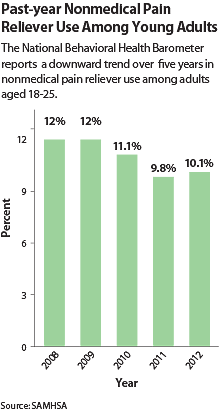Recent Mental Health Trends Provide Reasons for Optimism
Abstract
A new report from a federal mental health agency documents progress in several behavioral health care realms, including substance use.
As mental health professionals and advocates persistently work toward reducing the negative impact of mental illness on American communities, a new report from the Substance Abuse and Mental Health Services Administration (SAMHSA) shows that these efforts are not in vain.
The National Behavioral Health Barometer (Barometer) is the beginning of a series of state and national reports providing a snapshot on the status of behavioral health in the United States, according to SAMHSA Administrator Pamela Hyde, J.D.
“This national report presents a set of substance use and mental health indicators as measured through data collection efforts sponsored by SAMHSA, the Centers for Disease Control and Prevention, and the National Institute on Drug Abuse,” Hyde explained. She noted that the Centers for Medicare and Medicaid Services was also included in the Barometer study to provide data on the use of mental health and substance abuse treatment services by Medicare enrollees.

Data collected and analyzed in the Barometer study, which was released January 31, indicate that there has been improvement in behavioral health issues in some areas.
From 2008 to 2012, for example, many fewer adolescents aged 12 to 17 smoked cigarettes, dropping from 9.2 percent to 6.6 percent. This downward trend was observed among all ethnicities, with the largest decline seen among Hispanics—with use dropping from 7.9 percent to 4.8 percent.
There were also downward trends in prescription painkiller usage among youth, which decreased from 9.2 percent to 8.7 percent from 2007 to 2011, as well as for adults aged 18 to 25, which fell from 12 percent to 9.8 percent.
The Barometer study also showed that more people are receiving needed help in some “crucial areas.” From 2006 to 2010, the number for people receiving buprenorphine treatment for heroin addiction jumped 400 percent. In addition, the number of people getting outpatient treatment for behavioral health concerns through Medicare increased by more than 30 percent during this same time span.
On the downside, the Barometer showed that from 2008 to 2012, the rate of past-year depressive episodes among 12- to 17-year-olds rose from 8.3 percent to 9.1 percent, with no observed changes in mental health services provided to this population.
Though the prevalence rate for serious mental illness was relatively stable among women from 2008 to 2012, the rate in men increased from 2.6 percent to 3.2 percent. Men were, however, less likely to receive treatment for mental illness than women were—58 percent versus 66 percent, respectively.
Hyde expressed satisfaction with the development of the Barometer report and stated that it is a unique tool for insights into “real-world” implications of behavioral health issues across the nation.
“Unlike many behavioral health reports, its focus is not only on what is going wrong in terms of behavioral health, but what is improving and how communities might build on that progress,” she commented.
Hyde promised that as new data become available, indicators highlighted in the Barometer report will be updated to reflect the current state of the science in mental health, in addition to incorporation of new measures of interest. ■
“The Behavioral Health Barometer” is posted at http://store.samhsa.gov/product/SMA13-4796?from=carousel&position=1&date=0130214.



